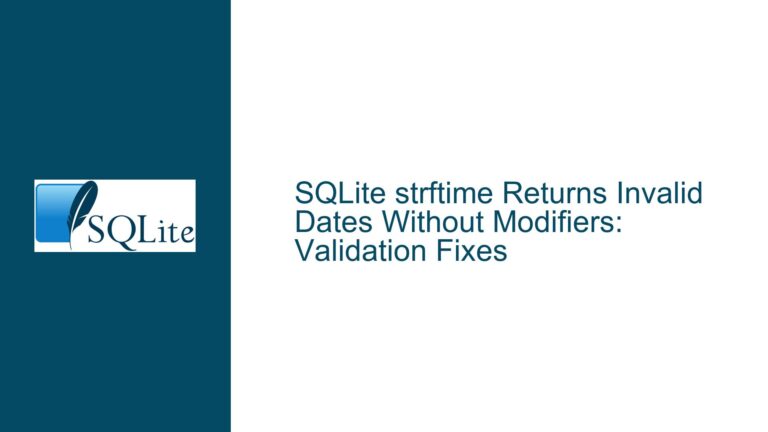UPSERT with RETURNING Clause: Retrieving Inserted Rows in SQLite
Understanding the UPSERT and RETURNING Clause Interaction in SQLite
The UPSERT operation in SQLite is a powerful feature that combines the functionality of INSERT and UPDATE into a single statement. It allows you to insert a new row into a table if it does not already exist, or update the existing row if a conflict arises. The RETURNING clause, on the other hand, is used to return the rows that were affected by the INSERT, UPDATE, or DELETE operations. However, when these two features are used together, particularly in the context of UPSERT, there are some nuances and limitations that need to be understood to effectively retrieve the rows that were inserted.
The core issue revolves around the ability to distinguish between rows that were inserted and those that were updated during an UPSERT operation. While the RETURNING clause can be used to retrieve the affected rows, it does not inherently differentiate between inserted and updated rows. This can be problematic in scenarios where you need to specifically track or store the rows that were inserted as opposed to those that were updated.
Possible Causes of the Issue
The primary cause of this issue stems from the way SQLite handles the RETURNING clause in conjunction with UPSERT operations. According to the SQLite documentation, the RETURNING clause in an UPSERT statement reports both inserted and updated rows. This means that when you use the RETURNING clause with an UPSERT, you will get a result set that includes all rows that were either inserted or updated, without a clear distinction between the two.
Another contributing factor is the limitation mentioned in the SQLite documentation regarding the RETURNING clause. Specifically, the RETURNING clause may only reference the table being modified. In the context of an UPSERT, the excluded table, which represents the rows that would have been inserted if there were no conflict, is considered an auxiliary table. This means that you cannot directly reference the excluded table in the RETURNING clause, which further complicates the ability to retrieve only the inserted rows.
Additionally, the SQLite documentation does not provide explicit guidance on how to use the RETURNING clause to differentiate between inserted and updated rows in an UPSERT operation. This lack of documentation can lead to confusion and misinterpretation of how these features can be used together effectively.
Troubleshooting Steps, Solutions & Fixes
To address the issue of retrieving only the inserted rows during an UPSERT operation in SQLite, several approaches can be considered. Each approach has its own set of advantages and limitations, and the choice of method will depend on the specific requirements of your use case.
1. Using a Common Table Expression (CTE) with UPSERT and RETURNING
One approach is to use a Common Table Expression (CTE) in conjunction with the UPSERT and RETURNING clauses. A CTE allows you to define a temporary result set that can be referenced within the main SQL statement. By using a CTE, you can first insert the rows into a temporary table and then use the RETURNING clause to retrieve the inserted rows.
Here’s an example of how this can be done:
WITH cte (NAME, value) AS (
VALUES ('fmX', 109), ('fmY', 'Perhaps')
)
INSERT INTO tblArchive (NAME, value)
SELECT NAME, value FROM cte
WHERE true
ON CONFLICT(NAME) DO UPDATE SET value = excluded.value
RETURNING *;
In this example, the CTE cte is used to define the rows that you want to insert into the tblArchive table. The INSERT INTO ... SELECT ... statement is then used to insert these rows into the tblArchive table. The ON CONFLICT clause specifies that if a conflict arises (i.e., if a row with the same NAME already exists), the value column should be updated with the value from the excluded table. Finally, the RETURNING * clause is used to return all the rows that were affected by the UPSERT operation.
However, as mentioned earlier, the RETURNING * clause will return both inserted and updated rows. To differentiate between the two, you can add a flag column to the tblArchive table that indicates whether a row was inserted or updated. For example, you could add a column named operation_type that is set to 'inserted' for newly inserted rows and 'updated' for rows that were updated.
2. Using a Temporary Table to Track Inserted Rows
Another approach is to use a temporary table to track the rows that were inserted during the UPSERT operation. This method involves creating a temporary table before performing the UPSERT operation, and then inserting the rows that were returned by the RETURNING clause into this temporary table.
Here’s an example of how this can be done:
-- Create a temporary table to store the inserted rows
CREATE TEMP TABLE temp_inserted_rows AS
SELECT * FROM tblArchive WHERE 1=0;
-- Perform the UPSERT operation and insert the returned rows into the temporary table
WITH cte (NAME, value) AS (
VALUES ('fmX', 109), ('fmY', 'Perhaps')
)
INSERT INTO tblArchive (NAME, value)
SELECT NAME, value FROM cte
WHERE true
ON CONFLICT(NAME) DO UPDATE SET value = excluded.value
RETURNING *;
-- Insert the returned rows into the temporary table
INSERT INTO temp_inserted_rows
SELECT * FROM tblArchive
WHERE rowid IN (SELECT rowid FROM tblArchive WHERE ...);
In this example, the temp_inserted_rows table is created to store the rows that were inserted during the UPSERT operation. The WITH cte ... statement is used to define the rows that you want to insert into the tblArchive table. The INSERT INTO ... SELECT ... statement is then used to insert these rows into the tblArchive table, and the RETURNING * clause is used to return all the rows that were affected by the UPSERT operation. Finally, the INSERT INTO temp_inserted_rows ... statement is used to insert the returned rows into the temp_inserted_rows table.
This approach allows you to track the rows that were inserted during the UPSERT operation, but it requires additional steps to create and manage the temporary table.
3. Using a Trigger to Track Inserted Rows
A more advanced approach is to use a trigger to track the rows that were inserted during the UPSERT operation. A trigger is a database object that is automatically executed in response to certain events on a particular table. In this case, you can create a trigger that is executed after an INSERT operation on the tblArchive table, and use this trigger to insert the newly inserted rows into a separate table.
Here’s an example of how this can be done:
-- Create a table to store the inserted rows
CREATE TABLE inserted_rows (
id INTEGER PRIMARY KEY,
NAME TEXT,
value TEXT
);
-- Create a trigger to insert the newly inserted rows into the inserted_rows table
CREATE TRIGGER track_inserted_rows
AFTER INSERT ON tblArchive
FOR EACH ROW
BEGIN
INSERT INTO inserted_rows (NAME, value)
VALUES (NEW.NAME, NEW.value);
END;
-- Perform the UPSERT operation
WITH cte (NAME, value) AS (
VALUES ('fmX', 109), ('fmY', 'Perhaps')
)
INSERT INTO tblArchive (NAME, value)
SELECT NAME, value FROM cte
WHERE true
ON CONFLICT(NAME) DO UPDATE SET value = excluded.value;
In this example, the inserted_rows table is created to store the rows that were inserted during the UPSERT operation. The track_inserted_rows trigger is created to automatically insert the newly inserted rows into the inserted_rows table. The WITH cte ... statement is used to define the rows that you want to insert into the tblArchive table, and the INSERT INTO ... SELECT ... statement is used to insert these rows into the tblArchive table.
This approach allows you to automatically track the rows that were inserted during the UPSERT operation, but it requires the creation of a trigger and an additional table to store the inserted rows.
4. Using a Combination of UPSERT and SELECT to Identify Inserted Rows
Another approach is to use a combination of UPSERT and SELECT statements to identify the rows that were inserted during the UPSERT operation. This method involves performing the UPSERT operation and then using a SELECT statement to retrieve the rows that were inserted.
Here’s an example of how this can be done:
-- Perform the UPSERT operation
WITH cte (NAME, value) AS (
VALUES ('fmX', 109), ('fmY', 'Perhaps')
)
INSERT INTO tblArchive (NAME, value)
SELECT NAME, value FROM cte
WHERE true
ON CONFLICT(NAME) DO UPDATE SET value = excluded.value;
-- Retrieve the rows that were inserted
SELECT * FROM tblArchive
WHERE NAME IN ('fmX', 'fmY')
AND rowid NOT IN (SELECT rowid FROM tblArchive WHERE ...);
In this example, the WITH cte ... statement is used to define the rows that you want to insert into the tblArchive table. The INSERT INTO ... SELECT ... statement is then used to insert these rows into the tblArchive table. After the UPSERT operation is performed, the SELECT * FROM tblArchive ... statement is used to retrieve the rows that were inserted.
This approach allows you to identify the rows that were inserted during the UPSERT operation, but it requires additional logic to determine which rows were inserted.
5. Using a Custom Function to Track Inserted Rows
Finally, you can create a custom function to track the rows that were inserted during the UPSERT operation. This method involves defining a function that performs the UPSERT operation and returns the rows that were inserted.
Here’s an example of how this can be done:
-- Create a custom function to perform the UPSERT operation and return the inserted rows
CREATE FUNCTION upsert_and_return_inserted(NAME TEXT, value TEXT)
RETURNS TABLE (id INTEGER, NAME TEXT, value TEXT) AS $$
DECLARE
inserted_row tblArchive%ROWTYPE;
BEGIN
-- Perform the UPSERT operation
INSERT INTO tblArchive (NAME, value)
VALUES (NAME, value)
ON CONFLICT(NAME) DO UPDATE SET value = excluded.value
RETURNING * INTO inserted_row;
-- Return the inserted row
RETURN QUERY SELECT * FROM tblArchive WHERE rowid = inserted_row.rowid;
END;
$$ LANGUAGE plpgsql;
-- Use the custom function to perform the UPSERT operation and retrieve the inserted rows
SELECT * FROM upsert_and_return_inserted('fmX', 109);
In this example, the upsert_and_return_inserted function is created to perform the UPSERT operation and return the rows that were inserted. The INSERT INTO ... VALUES ... statement is used to insert the rows into the tblArchive table, and the RETURNING * INTO inserted_row clause is used to store the inserted row in the inserted_row variable. Finally, the RETURN QUERY SELECT * FROM tblArchive WHERE rowid = inserted_row.rowid statement is used to return the inserted row.
This approach allows you to encapsulate the UPSERT operation and the logic to retrieve the inserted rows in a single function, but it requires the creation of a custom function.
Conclusion
Retrieving only the inserted rows during an UPSERT operation in SQLite can be challenging due to the limitations of the RETURNING clause and the way SQLite handles the excluded table. However, by using a combination of techniques such as Common Table Expressions (CTEs), temporary tables, triggers, custom functions, and SELECT statements, you can effectively track and retrieve the rows that were inserted during an UPSERT operation. Each approach has its own set of advantages and limitations, and the choice of method will depend on the specific requirements of your use case. By understanding these techniques and their implications, you can ensure that your SQLite database operations are both efficient and effective.






